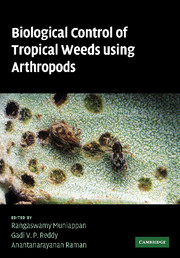Book contents
- Frontmatter
- Contents
- List of contributors
- Acknowledgments
- 1 Biological control of weeds in the tropics and sustainability
- 2 Acacia nilotica ssp. indica (L.) Willd. ex Del. (Mimosaceae)
- 3 Australian Acacia species (Mimosaceae) in South Africa
- 4 Ageratina adenophora (Sprengel) King and Robinson (Asteraceae)
- 5 Azolla filiculoides Lamarck (Azollaceae)
- 6 Cabomba caroliniana Gray (Cabombaceae)
- 7 Invasive cactus species (Cactaceae)
- 8 Chromolaena odorata (L.) King and Robinson (Asteraceae)
- 9 Clidemia hirta (L.) D. Don (Melastomataceae)
- 10 Coccinia grandis (L.) Voigt (Cucurbitaceae)
- 11 Eichhornia crassipes (Mart.) Solms–Laub. (Pontederiaceae)
- 12 Lantana camara Linn. (Verbenaceae)
- 13 Mimosa diplotricha C. Wright ex Sauvalle (Mimosaceae)
- 14 Mimosa pigra L. (Leguminosae)
- 15 Parthenium hysterophorus L. (Asteraceae)
- 16 Passiflora mollissima (HBK) Bailey (Passifloraceae)
- 17 Pistia stratiotes L. (Araceae)
- 18 Prosopis species (Leguminosae)
- 19 Salvinia molesta D. S. Mitchell (Salviniaceae)
- 20 Solanum mauritianum Scopoli (Solanaceae)
- 21 Application of natural antagonists including arthropods to resist weedy Striga (Oranbanchaceae) in tropical agroecosystems
- 22 Biological control of weeds in India
- 23 The role of International Institute of Tropical Agriculture in biological control of weeds
- 24 The role of Secretariat of the Pacific Community in the biological control of weeds in the Pacific Islands region – past, present, and future activities
- Index
15 - Parthenium hysterophorus L. (Asteraceae)
Published online by Cambridge University Press: 04 August 2010
- Frontmatter
- Contents
- List of contributors
- Acknowledgments
- 1 Biological control of weeds in the tropics and sustainability
- 2 Acacia nilotica ssp. indica (L.) Willd. ex Del. (Mimosaceae)
- 3 Australian Acacia species (Mimosaceae) in South Africa
- 4 Ageratina adenophora (Sprengel) King and Robinson (Asteraceae)
- 5 Azolla filiculoides Lamarck (Azollaceae)
- 6 Cabomba caroliniana Gray (Cabombaceae)
- 7 Invasive cactus species (Cactaceae)
- 8 Chromolaena odorata (L.) King and Robinson (Asteraceae)
- 9 Clidemia hirta (L.) D. Don (Melastomataceae)
- 10 Coccinia grandis (L.) Voigt (Cucurbitaceae)
- 11 Eichhornia crassipes (Mart.) Solms–Laub. (Pontederiaceae)
- 12 Lantana camara Linn. (Verbenaceae)
- 13 Mimosa diplotricha C. Wright ex Sauvalle (Mimosaceae)
- 14 Mimosa pigra L. (Leguminosae)
- 15 Parthenium hysterophorus L. (Asteraceae)
- 16 Passiflora mollissima (HBK) Bailey (Passifloraceae)
- 17 Pistia stratiotes L. (Araceae)
- 18 Prosopis species (Leguminosae)
- 19 Salvinia molesta D. S. Mitchell (Salviniaceae)
- 20 Solanum mauritianum Scopoli (Solanaceae)
- 21 Application of natural antagonists including arthropods to resist weedy Striga (Oranbanchaceae) in tropical agroecosystems
- 22 Biological control of weeds in India
- 23 The role of International Institute of Tropical Agriculture in biological control of weeds
- 24 The role of Secretariat of the Pacific Community in the biological control of weeds in the Pacific Islands region – past, present, and future activities
- Index
Summary
Introduction
Parthenium hysterophorus L. (Asteraceae), commonly known as parthenium, is a weed of global significance (Navie et al., 1996; Fig. 15.1). Parthenium is a major weed in Australia and India. In Australia, parthenium was first identified in 1955, but was proclaimed as a noxious plant in 1975 (Auld et al., 1983). Parthenium was accidentally introduced into India in 1955 (Rao, 1956), and has since spread to neighboring countries, including Pakistan (Javaid and Anjum, 2005; Shabbir and Bajwa, 2006), Sri Lanka (Jayasuriya, 2005), Bangladesh, and Nepal. Parthenium also occurs in southern China, Taiwan, Vietnam, and Israel in Asia (Nath, 1981; Joel and Liston, 1986), several Pacific islands including New Caledonia, Papua New Guinea, Seychelles, Vanuatu (Adkins et al., 2005), and several African countries including Ethiopia, Kenya, Madagascar, Mozambique, South Africa, Somalia, Swaziland, and Zimbabwe (i.e. Wood, 1897; Hilliard, 1977; Njoroge, 1986, 1989, 1991; Nath, 1988; Frew et al., 1996; Tamado and Milberg 2000; Tamado et al., 2002a; MacDonald et al., 2003; CABI, 2004; Da Silva et al., 2004; Fessehaie et al., 2005; Taye et al., 2004b; Strathie et al., 2005) (Fig. 15.1).
Parthenium is an annual herb with a deep-penetrating taproot system and an erect shoot system. Young plants form a rosette of leaves close to the soil surface. As it matures, the plant develops many branches on its upper half, and may eventually grow up to two meters (McFadyen, 1992).
- Type
- Chapter
- Information
- Biological Control of Tropical Weeds Using Arthropods , pp. 274 - 318Publisher: Cambridge University PressPrint publication year: 2009
- 20
- Cited by

